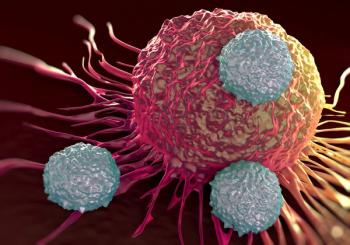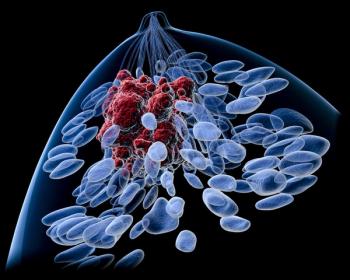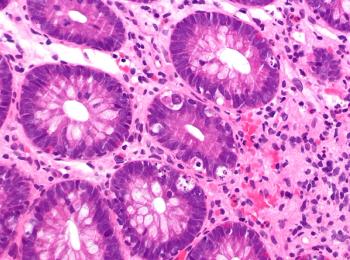
FDA Approves Revumenib in R/R NPM1-Mutant AML
Results from the phase 1/2 AUGMENT-101 trial support the FDA’s decision for approving revumenib in this NPM1-mutated, relapsed/refractory AML population.
The FDA has approved revumenib (Revuforj) as a therapy for patients 1 year or older with relapsed/refractory acute myeloid leukemia (AML) harboring NPM1 mutations who have no satisfactory alternative treatment options, according to a press release from the FDA.1
Supporting results from the decision came from the phase 1/2 AUGMENT-101 trial (NCT04065399), which evaluated revumenib in patients with relapsed/refractory leukemias, including those with NPM1 mutations. Data were most recently presented at the
Previously, in June 2025,
What was the efficacy of the AUGMENT-101 trial?
The rate of patients who achieved a complete remission (CR) or CR with partial hematologic recovery (CRh) was 23.4% (95% CI, 13.8%-35.7%; P = .0014). The composite CR (CRc) rate was 29.7% (95% CI, 18.9%-42.4%), and the overall response rate (ORR) was 46.9% (95% CI, 34.3%-59.8%).
The median time to first response was 1.84 months (range, 0.9-4.6), with a median time to first CR or CRh of 2.76 months (range, 1.8-8.8). The median duration of CR plus CRh was 4.7 months (95% CI, 1.2-8.2), and the median duration of CRc was 4.7 months (95% CI, 1.9-8.2).
Per subgroup analyses, responses were observed despite previous hematopoietic stem cell transplantation (HSCT) and number of prior lines of therapy; CR plus CRh rates were similar among patients younger than 65 years old and patients 65 years or older.
The median event-free survival (EFS) was 3.0 months (95% CI, 2.0-3.8); the median overall survival (OS) was 4.0 months (95% CI, 2.5-7.2), and the median OS in patients with a CR or CRh response was 23.3 months (95% CI, 7.2-not reached [NR]).
Notably, 1 pediatric patient (female, 11 years old) was not included in the primary efficacy analysis. She was diagnosed 98.2 months prior to study enrollment, had an IDH2 mutation at baseline, had received 4 prior treatments, and had undergone HSCT. Her duration of treatment was 17.6 months, during which she achieved a CRh response. For 2 cycles after the response was achieved, treatment continued until the patient relapsed and withdrew consent from the study.
How was the AUGMENT-101 trial designed?
A total of 84 patients with relapsed/refractory NPM1-mutated AML were administered at least 1 dose of revumenib and were included in the safety population. The efficacy-evaluable population included 64 patients.
Revumenib was administered orally via capsule, tablet, or liquid formulation every 12 hours in 28-day continuous cycles; the recommended phase 2 dose was 270 mg, or 160 mg/m2 if body weight was less than 40 kg, every 12 hours; if patients were also receiving a strong CYP3A4 inhibitor, revumenib was administered at 160 mg, or 95 mg/m2 if body weight was less than 40 kg. Treatment was continued until lack of response following up to 4 cycles, disease progression or unacceptable toxicity, among other reasons.
The primary end points of the trial were the CR plus CRh rate and safety and tolerability. Secondary end points were CRc rate, ORR, time to response, duration of response, EFS, and OS.
What was the safety profile of revumenib?
Treatment-emergent adverse effects (TEAEs) of any grade occurred in 98.8% of patients, and TEAEs of grade 3 or higher occurred in 91.7%. Any-grade treatment-related AEs (TRAEs) due to revumenib occurred in 78.6% of patients, and grade 3 or higher TRAEs occurred in 59.5%.
TRAEs led to dose interruptions, dose reductions, and revumenib discontinuation in 66.7%, 11.9%, and 4.8%, respectively; 1 patient died due to a TRAE.
Notably, treatment-emergent differentiation syndrome occurred in 19.0% of patients, with grade 3 and 4 instances occurring in 10.7% and 2.4%, respectively. The median time to initial onset was 10 days (range, 4-34), and the median duration of initial event was 14.5 days (range, 3-57).
Treatment-emergent QTcF prolongation occurred in 42.9% of patients, of which 20.2% were grade 3 and 2.4% were grade 4. The median time to initial onset was 8 days (range, 1-84), and the median duration of the initial event was 4 days (range, 1-14).
No patient discontinued treatment due to a grade 3 or higher cytopenia or electrolyte imbalance.
References
- FDA approves revumenib for relapsed or refractory acute myeloid leukemia with a susceptible NPM1 mutation. News release. FDA. October 24, 2025. Accessed October 24, 2025. https://tinyurl.com/2s5fenvy
- Arellano ML, Thirman MJ, DiPersio JF, et al. Revumenib for patients with relapsed or refractory (R/R) nucleophosmin 1–mutated (NPM1m) acute myeloid leukemia (AML): updated results from the phase 2 AUGMENT-101 study. Abstract presented at: European Hematology Association 2025 Congress; June 12-15, 2025; Milan, Italy. Abstract PS1467.
- Arellano ML, Thirman MJ, DiPersio JF, et al. Menin inhibition with revumenib for NPM1-mutated relapsed or refractory acute myeloid leukemia: the AUGMENT-101 study. Blood. Published online May 7, 2025. Accessed May 8, 2025. doi:10.1182/blood.2025028357
- Syndax announces FDA priority review of sNDA for Revuforj (revumenib) in relapsed or refractory mNPM1 acute myeloid leukemia. News release. Syndax Pharmaceuticals. June 24, 2025. Accessed October 20, 2025. https://tinyurl.com/spy4tn6r
Newsletter
Stay up to date on recent advances in the multidisciplinary approach to cancer.

















































































